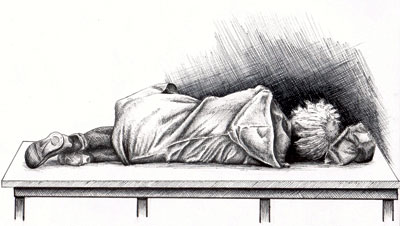All Nonfiction
- Bullying
- Books
- Academic
- Author Interviews
- Celebrity interviews
- College Articles
- College Essays
- Educator of the Year
- Heroes
- Interviews
- Memoir
- Personal Experience
- Sports
- Travel & Culture
All Opinions
- Bullying
- Current Events / Politics
- Discrimination
- Drugs / Alcohol / Smoking
- Entertainment / Celebrities
- Environment
- Love / Relationships
- Movies / Music / TV
- Pop Culture / Trends
- School / College
- Social Issues / Civics
- Spirituality / Religion
- Sports / Hobbies
All Hot Topics
- Bullying
- Community Service
- Environment
- Health
- Letters to the Editor
- Pride & Prejudice
- What Matters
- Back
Summer Guide
- Program Links
- Program Reviews
- Back
College Guide
- College Links
- College Reviews
- College Essays
- College Articles
- Back
Sleep Paralysis
Many people in the world live with various sleep disorders. One of the more interesting ones, sleep paralysis, will occur to everyone at least once in their lifetime. It takes effect in the split second between sleeping and waking up. Those who have experienced it still feel fuzzy and tired, but when they move to get out of bed, they can’t. Sleep paralysis prevents one from moving any parts of their body except their eyes, and it can last anywhere from a few seconds to a few hours. Occasionally the person experiences a severe form, called hallucinatory sleep paralysis. The same restrictions apply, but terrifying, life-like hallucinations come along with it. Even scarier, this strange disorder, which might seem rare, is much more common than you think.
A typical episode will involve someone, either falling asleep or waking up, having the feeling of consciousness, but also a temporary inability to move. Some people wake up suddenly, feeling extremely tense and terrified, their heart pounding. Symptoms of the true disorder include frequent occurrences of these moments of paralysis, as few people experience them more than once in their life. Most victims feel anxious and exhausted throughout the day. During the actual paralysis, most reports share several of the same specific symptoms. Feeling ‘awake’ or conscious, inability to move, overwhelming fear or dread, sensing an unknown presence, heavy pressure on the chest, difficulty breathing, and altered visual/auditory/sensual perception are among these aspects. According to several people who must deal with this disease on a regular basis, the recovery from the paralysis is not instantaneous. The ability to move comes back slowly, and the amount of time varies from person to person. Even though these symptoms can seem very frightening or supernatural, the causes do sound much more rational and have a logical basis.
Sleeping humans go through a few different stages while unconscious-Stages 1, 2, 3, 4, and REM sleep. REM sleep is the stage where dreaming happens, and our minds subconsciously limit our motion during that time. Scientists aren’t entirely sure how REM causes sleep paralysis, but the most likely and widely accepted theory is that REM lasts too long and the limitation of muscles has not faded by the time we wake up. Other researched causes that affect this abnormality are age, irregular sleeping patterns, sleep deprivation, and family history. There have also been scattered tales in which somebody hears about the disorder, and then it strikes them, and others where outbreaks were recorded from specific geographical locations. No data has sufficiently proved either theory, but both make one question the reality of the disease. In the modern era we know almost everything about sleep paralysis, but mystery still surrounds it, and we cannot forget the events of the past.
There have been reports of sleep paralysis, hallucinatory and normal, from all cultures and areas of the world, for hundreds of years. Shared experiences, medical records, and even artwork tell a ghastly story regarding the origins of the disorder. It was originally called “Incubus”, then “The Night-Mare”, “Old Hag Syndrome”, and now “(Hallucinatory) Sleep Paralysis” due to its horrific symptoms. Stories describing run-ins with the disease all mention the same thing: a feeling of terror, and someone sitting on the victim’s chest, usually choking them. To those experiencing the paralysis, the hallucinations appear vivid and completely real, which played a role in Medieval beliefs and later movements like the Salem Witch Trials. Townspeople of course blamed the sensations on a “witch”, who was usually a local social outcast (This provided inspiration for “Old Hag Syndrome). Looking at the history of the disease paints an unpleasant picture, and plants the seeds of worry knowing that anyone can and almost certainly will have to go through a disturbing incident at some point in their life .
Now, to dial back a bit... yes, this disorder affects many people each year. The statistics do not lie, and the symptoms and causes are all true as well. That being said, one could easily get wrapped up in the history and confusion shrouding the disorder, but, in the end, that’s all it is. A very nebulous and outlandish sleep disorder.

Similar Articles
JOIN THE DISCUSSION
This article has 0 comments.

I had heard a little about sleep paralysis before, but my sister more recently learned about it in her psychology class. She mentioned it to me which prompted me to do more research, and I ended up writing a short article about the subject for a school project.